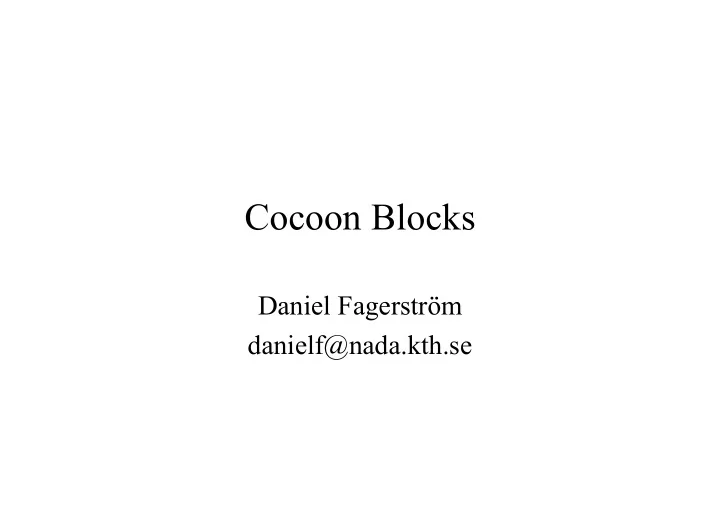

Cocoon Blocks Daniel Fagerström danielf@nada.kth.se
Motivation • Cocoon is great but … • Monolithic – Huge download – Complicated configuration – Steep threshold – Few third party applications and components – ”Classloading hell”
Blocks • A plugin architecture is needed • Designed by Stefano and the rest of the community 3+ years ago • Compile time blocks for a few years, but no external contracts • Much work and discussion, but less progress until the last half year • Essentially back compatible, a new integration level: package and reuse applications
Overview • The big picture • Architecture – Examples • Current state and next steps
What is a block? • A packaged application (or part) containing: – Libraries and resources – Components – Sitemap functionality • Configurable at deploy time • Might depend on other blocks • Isolated internals
What is a Block? Sitemap Registered Used services services Components Export packages Import packages Classes,resources
Deployment architecture Blocks repository (Maven 2) Blocks Deployment service Blocks discovery Cocoon platform
Block Architecture • Built upon OSGi (same as Eclipse 3+) • A block is an OSGi bundle – Class loader isolation – Packaging format – Services – Security – Hot deployment possible
OSGi
OSGi • Standardized, component oriented, computing environment for networked services • Since 1998 • 80+ members • R3, soon R4 • 10+ implementations • Smart phones, home automation, BMW 5, Eclipse
OSGi Overview • Secure execution environment • Bundles (applications) • Life cycle management • Service architecture • Standard services
Bundles • Applications • JAR containing – Compiled code – Resources – JARs that the code depend on – Meta information – manifest.mf
Class sharing • Import-Package • DynamicImport- Package • Export-Package • Bundle-Classpath
Activator Activator Activator BundleCtx BundleCtx OSGi Framework
Life cycle
Manifest.mf Manifest-Version: 1.0 Bundle-Name: cocoon_servlet Bundle-Version: 1.0.0 Bundle-Description: Cocoon servlet bundle Bundle-Vendor: Apache Bundle-DocURL: http://cocoon.apache.org Bundle-ContactAddress: http://cocoon.apache.org Bundle-Activator: org.apache.cocoon.service.servlet.impl.Activator Bundle-Category: servlet Import-Package: javax.servlet,javax.servlet.http, org.apache.cocoon.servlet, org.osgi.framework,org.osgi.service.http, org.osgi.service.log,org.osgi.util.tracker
Blocks
Block structure myblock/ META-INF/ MANIFEST.MF # bundle manifest BLOCK-INF/ block.xml # block configuration myblock.xconf # exported components classes/ lib/ src/ sitemap.xmap # block sitemap resources/ ...
Block configuration <block xmlns="http://apache.org/cocoon/blocks/cob/1.0" id="http://cocoon.apache.org/blocks/blog-123"> <name>blog</name> <sitemap src="sitemap.xmap"/> <components> <include src="blog.xconf"/> </components> <properties> <property name=“cmsURL"> <default>http://mycms.com/test</default> </property> </properties> <requirements> <requires interface="http://cocoon.apache.org/blocks/editor/1.0" name=“editor"/> </requirements> </block>
Wiring blog Uses editor: cmsURL: http://mycms.com/... myeditor myblog Extends super: mountPath: /blog/danielf/
wiring.xml <wiring xmlns="http://apache.org/cocoon/blocks/wiring/1.0"> <block id="blog-123" location="file:/blocks/blog-1.4.jar"> <connections> <connection name="editor" block="editor-234"/> </connections> <properties> <property name="cmsURL“ value="http://mycms.com/danielf/"/> </properties> </block> <block id="editor-234" location="file:/blocks/editor-1.4.jar"/> <block id="myblog-345" location="file:/blocks/myblog/"> <mount path="/blog/danielf/"/> <connections> <connection name="super" block="blog-123"/> </connections> </block> </wiring>
Components in blocks • Components only available from the own block and connected blocks
Component bridge OSGi service Cocoon Cocoon component component manager manager
Sitemaps in blocks • As usual • Adds – Call sitemaps in connected blocks – Use block deploy time attributes – Extend blocks (with polymorphism)
Block architecture Blocks Http Service /editor / Webapp OSGi Servlet wiring.xml settings
Block protocol block:/foo.xml – root sitemap in current block block:./bar.xml – current sitemap in current block block:editor:/foo.xml – root sitemap in editor block block:super:/foo.xml – root sitemap in extended block
Block properties, paths {block-property:cmsURL} - Block property in sitemap (input module) {cmsURL} - Block property in component configuration {block-path:myblog:/start} --> /blog/danielf/start - “Absolutizes” block protocol URIs to mounted URIs, used in link transformer
Sitemap polymorphism blog “skin.xsl” read “skin.xsl” Extends Empty myblog “skin.xsl”
Sitemap polymorphism blog “skin.xsl” read “skin.xsl” Extends Override myblog “skin.xsl” “skin.xsl” read “myskin.xsl”
Sitemap polymorphism blog “skin.xsl” read “skin.xsl” “*.xml” generate “{1}” transform “block:/skin.xsl” serialize Extends myblog “skin.xsl” “start.xml” read “myskin.xsl”
Scenario • Download blog block • Deploy with parameters (or use default) – Test • Create empty extension (skeleton generator) – Test • Override some default or example rule – Test • …
Summary Blocks gives us: • Binary application packages – Classes & resources – Components – Sitemap functionality • Parameterizable applications • Reusability by extension • Dependency handling between applications
Current state • Cocoon runs under OSGi • Sitemap blocks works • Component bridge implemented • Above parts are not yet integrated • Maven 2 build on its way
Next steps • 2.2 – Binary distribution of all blocks in M2 repository – Blocks architecture in experimental version, without OSGi • 3.0 – OSGi based – class loader isolation – partial hot plugablillity
Recommend
More recommend